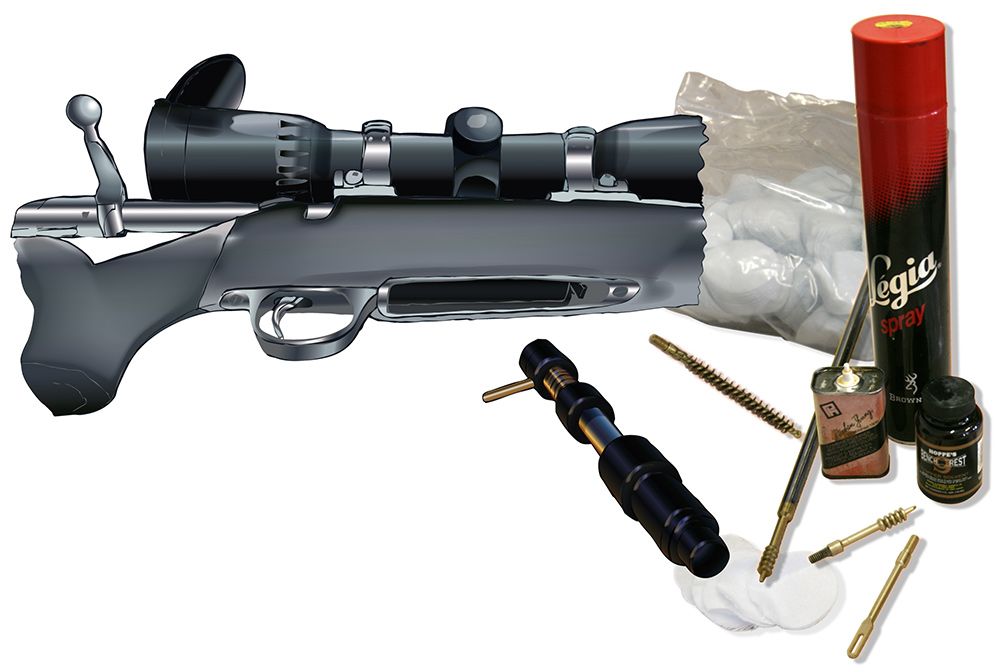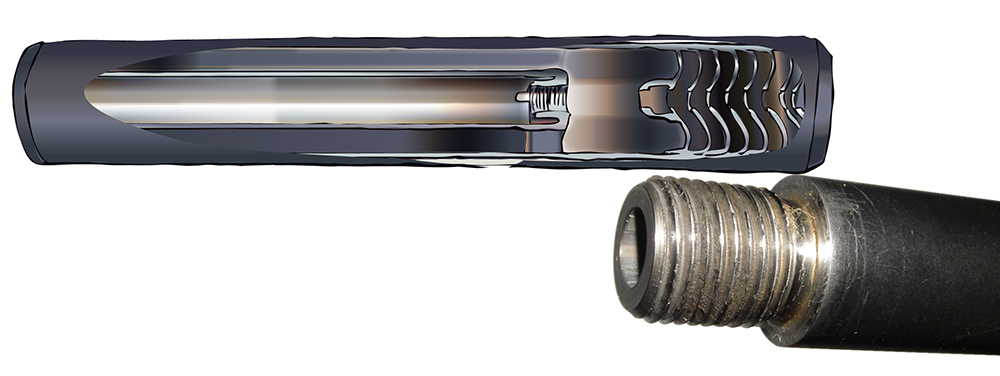
rifle cleaning kit together with bore guide
Introduction
In order to function safely and accurately firearms must be maintained in a clean and fully functioning condition. This guide describes the regular maintenance that can be carried out by the user. It is recommended that any other maintenance is done by a qualified gunsmith.
This guide links to others in the Firearms series.
General
The condition of a firearm is important. Rusted, damaged or blocked barrels may be unsafe and fouling, corrosion or damage may cause mechanisms to fail. If there is any doubt as to its condition, a firearm should not be used until it has been properly checked and repaired. Allowing even small amounts of fouling to build up in the rifling can reduce the consistency of accuracy. Ensure rifles are serviced annually by a competent gunsmith.
Cleaning equipment
Having the proper cleaning equipment for use with specific calibers of firearm is essential. Cleaning kits generally include:
- Plastic coated or quality solid steel rods of the correct diameter. Rods should be long enough to push a brush clear of the muzzle but otherwise as short as possible;
- A good quality bore guide (prevents brushes and jags from damaging the throat of the barrel and keeps the rod aligned all the way down the barrel, protecting the rifling. Also prevents solvents and debris entering the magazine or trigger mechanism);
- Spear tip jags and good cotton cut patches sized to fit down the bore;
- Specialist cleaning oils and copper solvents. Follow the manufacturers instructions to ensure that prolonged contact or misuse does not damage the rifling;
- Good quality bronze brushes with a brass core;
- A small stiff brush e.g. toothbrush;
- An action cleaning kit including chamber rods, industrial-type tissue paper and dental rolls.

the inside of the moderator and (right) the crown of barrel
Cleaning programme
Before cleaning or storing a rifle ensure that the rifle is in a safe condition, see Stage 1 in the Rifle Safety guide, and that ammunition is stored separately.
Stored rifles
- Rifles not in daily use should be stored in a clean and lightly oiled state. The oil must be removed from the barrel before the rifle is used. Failure to do so may cause damage to the barrel.
Rifles in daily use
- At the end of each day’s outing, clean and dry the exterior of the rifle.
- If the rifle is wet or cold, dry the outside of the rifle thoroughly with a clean, dry rag. Let the rifle stand for an hour or so in a secure place to adjust to indoor temperature and allow condensation to dispel. Do not place the rifle or parts directly onto hot surfaces such as central heating radiators. Do not put damp firearms into gun cabinets, as rusting will start immediately, especially if there are any traces of blood left on the metal work.
- Using an appropriate oil/solvent, put a cotton patch through the bore then use dry patches to leave the bore clean and free of oil.
- Apply a light coat of oil to the metal surfaces.
Regular deep clean
General
- Clean the rifle thoroughly at least once a week or after every 15 to 25 shots.
- Remove muzzle accessories such as sound moderators or muzzle brakes prior to cleaning.
- Check barrel for rusting, pitting and dents. If any of these are found, seek advice from a gunsmith.
Barrel and chamber
- Using a bore guide, push a patch soaked in copper solvent through the barrel.
- Leave the solvent in for the time stated by the manufacturers and patch out with clean tight cotton patches.
- If the patches have blue copper deposits push a brush with solvent through the barrel and completely out of the muzzle.
- To maintain the quality of the solvent, do not dip the brush into the solvent bottle as this will contaminate the solvent inside.
- Use roughly one cleaning stroke per shot since the last cleaning, this is normally around 15 to 25 strokes. Ensure the brush has exited the barrel completely if changing direction of the stroke. This will prolong the life of the brush.
- Clean out the barrel with clean, dry patches. Do not withdraw the patch back through the barrel.
- Repeat task if the patches are still coming out blue or copper coloured. If two attempts at brushing do not remove the copper then seek advice from a gunsmith.
- When patches are coming out clean, remove the bore guide and swab out the chamber with some tissue paper on a jag or chamber stick to remove dirt and excess solvents.
- Ensure that all cleaning materials have been removed from the bore and that the bore is free from obstruction.
- Lightly oil the surface of the barrel with gun oil, taking care not to get oil on the glass surfaces of the sight.
Muzzle brakes and sound moderators
- Always remove muzzle accessories prior to cleaning and after each shooting session. Large amounts of fouling will build up on the crown and should be removed in order to prevent corrosion. Condensation can also gather, causing rusting. Muzzle accessories should be maintained as per their instruction manuals.
- Clean the interior according to the manufacturer’s instructions.
- A small amount of oil/light grease should be applied to the threads prior to refitting the brake or moderator.
- Neoprene covers should be removed and dried.
- Lightly oil the exterior of the moderator or muzzle brake according the manufacturer’s recommendations.
Locking lug recess & bolt lugs
- Where the bolt lugs lock into the action is difficult to access and yet important to clean.
- An action cleaning kit with cotton dental rolls should be used to clean out any accumulated dirt.
- Bolt lugs should be wiped off and lubricated every time the rifle is used. Use a very small quantity of light grease.
Cocking cam
- Apply a small quantity of grease to this area to aid smooth operation and reduced wear.
Firing pin assembly
- A consistent firing pin strike on the primer is critical for best accuracy. Do not pack full of grease as this will only impair a consistent strike.
- Light oiling should be sufficient to ensure no corrosion takes place around the firing pin. It is advisable to remove tension from the firing pin when the rifle is not in use for long periods.
- Do not attempt to disassemble the bolt unless you are experienced with that particular rifle or have consulted a gunsmith first.
Bedding
- If the rifle has a floating barrel check there are no obstructions, dirt or water between the barrel and the stock. Use a stiff piece of card to check the clearance between them.
- If the rifle has a fully bedded barrel, check (with the stock of the rifle in a vice) there is no movement between the barrel and the stock.
- When the action is required to be removed from the stock for thorough cleaning and drying, specialist advice should be sought in the first instance until you are competent to carry out the task yourself.
Stock
- A rifle will maintain its point of impact and accuracy in a more consistent fashion if the stock stays stable. This not only means excluding water from the stock but also avoiding large variations in humidity and temperature over a short period of time. The common stock finishes such as oil and varnish work perfectly well providing they are maintained. Synthetic stocks can simply be wiped over with a cloth to ensure they are dry.
Trigger
- Triggers should be maintained clean and dry, grease and oil only serve to attract and hold dirt. Do not lubricate the trigger mechanism except with a dry lubricant if recommended by the manufacturer.
Scope
- Protect the lenses whilst cleaning the barrel as oil can destroy the lens coating. Care should also be taken when using any sprays near a scope.
- Blow loose dust off with an air supply.
- Soft, clean cloths should be used with the aid of lens cleaning fluid.
- Periodically check the position of the scope on the action to make sure it has not moved. Reposition and tighten as required, then re-zero rifle to ensure accuracy. (See Zeroing guide).
[printfriendly]